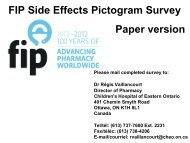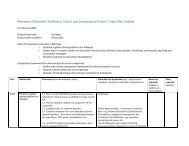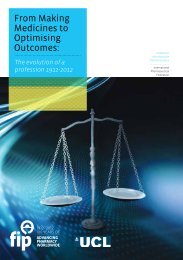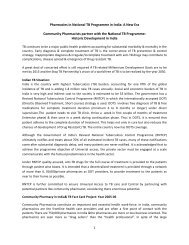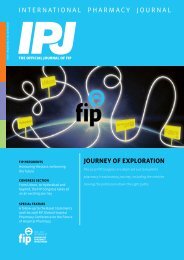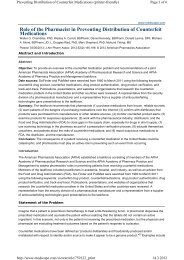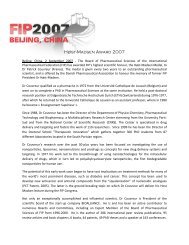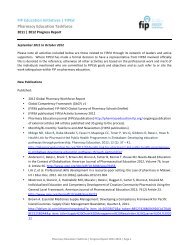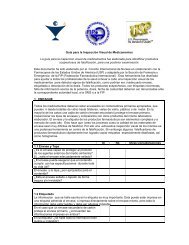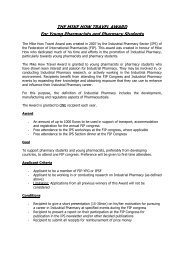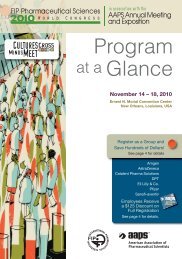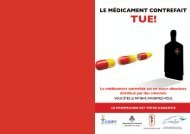Acetylsalicylic acid - FIP
Acetylsalicylic acid - FIP
Acetylsalicylic acid - FIP
Create successful ePaper yourself
Turn your PDF publications into a flip-book with our unique Google optimized e-Paper software.
Biowaiver Monograph for Immediate-Release Solid Oral Dosage<br />
Forms: <strong>Acetylsalicylic</strong> Acid<br />
JENNIFER B. DRESSMAN, 1 ANITA NAIR, 1 BERTIL ABRAHAMSSON, 2 DIRK M. BARENDS, 3 D. W. GROOT, 3 SABINE KOPP, 4<br />
PETER LANGGUTH, 5 JAMES E. POLLI, 6 VINOD P. SHAH, 7 MARKUS ZIMMER8 1Institute of Pharmaceutical Technology, Goethe University, Frankfurt am Main, Germany<br />
2 Pharmaceutical Development, AstraZeneca R&D, Mölndal, Sweden<br />
3 RIVM—National Institute for Public Health and the Environment, Bilthoven, the Netherlands<br />
4 World Health Organization, Geneva, Switzerland<br />
5 Institute of Pharmacy, Johannes Gutenberg University, Mainz, Germany<br />
6 Department of Pharmaceutical Sciences, School of Pharmacy, University of Maryland, Baltimore, Maryland<br />
7 International Pharmaceutical Federation, The Hague, the Netherlands<br />
8 YES Pharmaceutical Development Services GmbH, Friedrichsdorf, Germany<br />
Received 23 March 2012; revised 3 May 2012; accepted 4 May 2012<br />
Published online 6 June 2012 in Wiley Online Library (wileyonlinelibrary.com). DOI 10.1002/jps.23212<br />
ABSTRACT: A biowaiver monograph for acetylsalicylic <strong>acid</strong> (ASA) is presented. Literature<br />
and experimental data indicate that ASA is a highly soluble and highly permeable drug, leading<br />
to assignment of this active pharmaceutical ingredient (API) to Class I of the Biopharmaceutics<br />
Classification System (BCS). Limited bioequivalence (BE) studies reported in the literature<br />
indicate that products that have been tested are bioequivalent. Most of the excipients used in<br />
products with a marketing authorization in Europe are not considered to have an impact on<br />
gastrointestinal motility or permeability. Furthermore, ASA has a wide therapeutic index. Thus,<br />
the risks to the patient that might occur if a nonbioequivalent product were to be incorrectly<br />
deemed bioequivalent according to the biowaiver procedure appear to be minimal. As a result,<br />
the BCS-based biowaiver procedure can be recommended for approval of new formulations<br />
of solid oral dosage forms containing ASA as the only API, including both multisource and<br />
reformulated products, under the following conditions: (1) excipients are chosen from those<br />
used in ASA products already registered in International Conference on Harmonization and<br />
associated countries and (2) the dissolution profiles of the test and the comparator products<br />
comply with the BE guidance. © 2012 Wiley Periodicals, Inc. and the American Pharmacists<br />
Association J Pharm Sci 101:2653–2667, 2012<br />
Keywords: acetylsalicylic <strong>acid</strong> (ASA); absorption; bioavailability; bioequivalence; Biopharmaceutics<br />
Classification System; permeability; solubility; stability<br />
Correspondence to: Jennifer B. Dressman (Telephone: +49-<br />
69-79829680; Fax: +49-69-79829724; E-mail: dressman@em.unifrankfurt.de)<br />
A project of the International Pharmaceutical Federation (<strong>FIP</strong>),<br />
Focus Group BCS & Biowaiver, www.fip.org/bcs.<br />
This article reflects the scientific opinion of the authors and not<br />
necessarily the policies of regulating agencies, the International<br />
Pharmaceutical Federation (<strong>FIP</strong>), or the World Health Organization<br />
(WHO).<br />
Journal of Pharmaceutical Sciences, Vol. 101, 2653–2667 (2012)<br />
© 2012 Wiley Periodicals, Inc. and the American Pharmacists Association<br />
INTRODUCTION<br />
A biowaiver monograph of acetylsalicylic <strong>acid</strong> (ASA)<br />
based on literature data and additional solubility<br />
and dissolution experimental data is presented. In<br />
biowaiver monographs, the risks of assessing bioequivalence<br />
(BE) for a specific active pharmaceutical<br />
ingredient (API), including both reformulated products<br />
and new multisource drug products, based on<br />
in vitro rather than in vivo studies are evaluated under<br />
consideration of the biopharmaceutical and clinical<br />
properties of the API in question. On the basis<br />
JOURNAL OF PHARMACEUTICAL SCIENCES, VOL. 101, NO. 8, AUGUST 2012 2653
2654 DRESSMAN ET AL.<br />
of this evaluation, a recommendation is made as to<br />
whether a Biopharmaceutics Classification System<br />
(BCS)-based biowaiver approval for the new formulation<br />
is advisable or not. Guidances for reaching the<br />
decision to recommend or advise against a biowaiver<br />
decision have been published by the World Health<br />
Organization (WHO), 1 the European Medical Agency<br />
(EMA), 2 and the US Food and Drug Administration<br />
(FDA), 3 and these are taken into consideration in<br />
generating biowaiver monographs. Biowaiver monographs<br />
have already been published for a variety of<br />
APIs and are available online at the website of the International<br />
Pharmaceutical Federation (<strong>FIP</strong>) (URL:<br />
http://www.fip.org/www/index.php? id = 642).<br />
This biowaiver monograph pertains to drug products<br />
containing ASA as the only API and not to combination<br />
drug products.<br />
METHODS<br />
Literature Search<br />
A literature search was performed via Google and<br />
PubMed using keywords, including BCS, ASA, polymorphs,<br />
hydrate, absolute bioavailability, fraction absorbed<br />
(FA), pharmacokinetics, BE, mucosa, and hydrolysis.<br />
Solubility Determination of ASA<br />
In order to determine the solubility of ASA, buffers<br />
were prepared at four pH values: a 0.1 N hydrochloric<br />
<strong>acid</strong> (HCl) at pH 1.0, a 50 mM sodium phosphate<br />
buffer at pH 3.5 (which is equal to the pKa ofASA),a<br />
50 mM sodium acetate buffer at pH 4.5, and a 50 mM<br />
sodium phosphate buffer at pH 6.8. Preliminary experiments<br />
were carried out to estimate the solubility<br />
and, based on these results, an appropriate excess<br />
amount of ASA was added to volumetric flasks<br />
containing 250 mL of the HCl or buffer solution. The<br />
flasks were shaken in an incubator shaker at 37 ◦ C.<br />
The shaking time was 45 min for the 0.1 N HCl solutions,<br />
20 min for the pH 3.5 buffer solutions, and<br />
15 min for pH 4.5 and 6.8 buffer solutions. The shaking<br />
time was selected to ensure that no more than 2%<br />
of the dissolved ASA was hydrolyzed to salicylic <strong>acid</strong><br />
(SA). Triplicate sample preparations were carried out<br />
for the solubility testing at all pH levels. The pH values<br />
were measured before and after the dissolution of<br />
ASA.<br />
For the solubility studies, the following highperformance<br />
liquid chromatography (HPLC) method<br />
was used to measure the solution concentrations. The<br />
system comprised a Phenominex Luna C18 column<br />
(Phenomenex, Torrance, California), a mobile phase<br />
consisting of methanol and phosphate buffer at pH<br />
2.4, a photo diode array detector, a sample chamber<br />
in which the temperature is controlled at 4 ◦ Cto<br />
minimize the hydrolysis of ASA while waiting to be<br />
injected, and a 4 min run time for each sample injection.<br />
All samples were filtered through a 0.45 :m pore<br />
size syringe filter and diluted with solvent as necessary.<br />
The method adequately separated the ASA and<br />
SA and could precisely and accurately quantitate the<br />
amount of both ASA and SA in solutions. 4<br />
Stability-Indicating Dissolution Test of ASA Tablets<br />
Dissolution of aspirin tablets (batch no: BTA9T21;<br />
Bayer Vital GmbH, Leverkusen, Germany) was performed<br />
in simulated gastric fluid (SGFsp), pH 1.2,<br />
and simulated intestinal fluid (SIFsp), pH 6.8, using<br />
a DT 80 paddle apparatus (Erweka, Heusenstamm,<br />
Germany). The tablets were tested in 500 mL medium<br />
(freshly degassed), maintained at 37 ± 0.5◦C and<br />
stirred at 75 rpm using United States Pharmacopeia<br />
(USP) apparatus 2. Samples were withdrawn at 15<br />
and 30 min when tested in SGFsp and at 15, 30, and<br />
60 min in SIFsp. The withdrawn samples were immediately<br />
diluted with acetonitrile (ACN) and analyzed<br />
by an HPLC method based on that of Kees et al. 4<br />
An R-18e LichroCART R○ (125 × 4mm2 ,5:m; Merck<br />
KGaA, Darmstadt, Germany) column was used as a<br />
stationary phase. The mobile phase constituted of water,<br />
ACN, and 85% orthophosphoric <strong>acid</strong> (740:180:0.9).<br />
The flow rate was set at 1.8 mL/min and injection volume<br />
was 20 :L. ASA and SA were simultaneously detected,<br />
and concentrations were calculated from calibration<br />
curves of aspirin and SA, which were prepared<br />
by diluting stock solutions (prepared in ACN)<br />
to obtain concentration ranges of 30–200 :g/mL and<br />
3–20 :g/mL, respectively. Peak areas were measured<br />
at 237 nm using an ultraviolet detector and the concentrations<br />
of ASA and SA were determined by extrapolating<br />
the corresponding peak areas from the<br />
respective calibration curves.<br />
GENERAL CHARACTERISTICS<br />
Name: Aspirin (BAN); 5 ASA; 2-acetoxybenzoic <strong>acid</strong>.<br />
The structure is shown in Figure 1.<br />
Figure 1. Chemical structure of acetylsalicylic <strong>acid</strong>.<br />
JOURNAL OF PHARMACEUTICAL SCIENCES, VOL. 101, NO. 8, AUGUST 2012 DOI 10.1002/jps
Chemical formula: C9H8O4<br />
Molecular weight: 180.157 g/mol<br />
Therapeutic Indications, Dosing Recommendations and<br />
Therapeutic Index<br />
Review of the literature reveals that ASA is one<br />
of the most commonly used salicylate drugs. Salicylates<br />
belong to the pharmaceutical class of nonsteroidal<br />
anti-inflammatory drugs. Furthermore, ASA<br />
is used therapeutically as an anticoagulant, fibrinolytic<br />
agent, platelet aggregation inhibitor, and cyclooxygenase<br />
(COX) inhibitor.<br />
<strong>Acetylsalicylic</strong> <strong>acid</strong> has analgesic, antiinflammatory,<br />
and antipyretic properties. It is<br />
used in adults for the relief of mild to moderate<br />
pain such as headache, dysmenorrhea, myalgias, and<br />
dental pain. ASA is rapidly metabolized in vivo into<br />
the principal active metabolite, SA. ASA is also used<br />
in the management of pain and inflammation in acute<br />
and chronic rheumatic disorders such as rheumatoid<br />
arthritis, juvenile idiopathic arthritis, osteoarthritis,<br />
and ankylosing spondylitis. In the treatment of minor<br />
febrile conditions, such as colds or influenza, ASA can<br />
reduce temperature and relieve headache and joint<br />
and muscle pains. The pharmacological activities<br />
of ASA and SA in the treatment of pain cannot be<br />
segregated from a practical point of view.<br />
The usual oral dose of ASA as an analgesic and<br />
antipyretic is 300–1000 mg as a single dose, repeated<br />
every 4–8 h according to clinical needs. 6 The maximum<br />
daily dose is 3–4 g.<br />
<strong>Acetylsalicylic</strong> <strong>acid</strong> is also used for its antiplatelet<br />
activity in the initial treatment of cardiovascular disorders<br />
such as angina pectoris and myocardial infarction<br />
and for the prevention of cardiovascular events<br />
in patients at risk, noting that only ASA, and not SA,<br />
has an irreversible platelet effect. Other related uses<br />
include the treatment and prevention of cerebrovascular<br />
disorders such as stroke.<br />
Adverse events observed during treatment with<br />
ASA are generally mild in nature and reversible by<br />
dose reduction or discontinuation of treatment. 6 They<br />
include upper and lower gastrointestinal (GI) tract<br />
disorders (dyspepsia, GI, and abdominal pain, etc.),<br />
increased risk of bleeding (perioperative hemorrhage,<br />
hematoma, epistaxis, etc.), hypersensitivity reactions<br />
(asthma syndrome, rash, edema, etc.), transient hepatic<br />
impairment with increase in liver transaminase<br />
(very rare), dizziness, and tinnitus. 7 Indications for<br />
ASA therapy in children are extremely limited because<br />
of the risk of Reye’s syndrome, but include juvenile<br />
idiopathic arthritis and Still’s disease. 5<br />
Ingestion of more than 10 g of ASA may result<br />
in intoxication owing to disruption of <strong>acid</strong>–base<br />
homeostasis. 6 Effects of overdose include tinnitus, abdominal<br />
pain, hypokalemia, hypoglycemia, pyrexia,<br />
hyperventilation, dysrhythmia, hypotension, halluci-<br />
BIOWAIVER MONOGRAPH FOR ACETYLSALICYLIC ACID 2655<br />
nation, renal failure, confusion, seizure, coma, and<br />
even death. 8 A dose of 25–30 g can cause the death of<br />
an adult when no countermeasures are taken. 9<br />
Overall, the therapeutic range of ASA is not considered<br />
to be narrow. 10<br />
PHYSICOCHEMICAL PROPERTIES<br />
Salts, Esters, Polymorphs, and Hydrates<br />
<strong>Acetylsalicylic</strong> <strong>acid</strong> is usually given orally as the free<br />
<strong>acid</strong>, but various salts also exist. These include aluminum,<br />
calcium, and sodium salts as well as lysine<br />
salts, the latter of which are intended for intravenous<br />
administration. Furthermore, esters of ASA (alkylor<br />
aralkyl-substituted ASA such as methyl, ethyl, allyl,<br />
or benzyl acetylsalicylate) have been applied for<br />
the topical treatment of inflammation. In this monograph,<br />
only products containing ASA as the free <strong>acid</strong><br />
are considered. Hydrates of ASA have not been described<br />
in the literature, whereas as many as six polymorphs<br />
(obtained by recrystallization from different<br />
solvents and temperatures) have been reported. 11–13<br />
The commercial ASA, which demonstrates high dissolution<br />
characteristics, consists of crushed, irregular<br />
shaped crystals. 11,13 The polymorph of the commercial<br />
ASA has not been reported in the open literature.<br />
Partition Coefficient<br />
Log P is the n-octanol–water partition coefficient: log<br />
PASA = 1.18. 14 clogP is a partition coefficient calculated<br />
for uncharged molecules by using the clogP programme<br />
from BioByte Corporation (Claremont, California).<br />
Kasim et al. 14 reported a ClogPASA of 1.02,<br />
calculated using three different fragmentation methods<br />
based on atomic contributions to lipophilicity.<br />
pKa<br />
<strong>Acetylsalicylic</strong> <strong>acid</strong> is a weak <strong>acid</strong> and the pKa value<br />
has variously been reported as 3.49, 8 3.5, 5,14 and<br />
3.6. 15 Therefore, the solubility of ASA is pH dependent,<br />
increasing with increasing pH above the pKa. 10<br />
Solubility<br />
Values for solubility of ASA were obtained from several<br />
standard references. The European Pharmacopeia<br />
(Ph. Eur.) 16 states that ASA is slightly soluble<br />
in water (according to Ph. Eur. General Notices,<br />
100–1000 mL of solvent per gram of solute). The USP3 specifies its solubility as being one part solute in<br />
300 parts solvent (water). A summary of literature<br />
values for the aqueous solubility of ASA is given in<br />
Table 1.<br />
Review of the data published on the solubility of<br />
ASA reveals that the solubility data vary from study<br />
to study, that the sample preparation method was not<br />
always appropriate or described clearly, or that the<br />
DOI 10.1002/jps JOURNAL OF PHARMACEUTICAL SCIENCES, VOL. 101, NO. 8, AUGUST 2012
2656 DRESSMAN ET AL.<br />
Table 1. Aqueous Solubility Values for <strong>Acetylsalicylic</strong> Acid Taken from the<br />
Literature<br />
Solubility of <strong>Acetylsalicylic</strong> Acid in Water References<br />
Slightly soluble (15 ◦ C–25 ◦ C) (100–1000 mL of solvent/g of solute) 16<br />
Slightly soluble a 14<br />
1 in 300 a 17<br />
1 in 300 a 14<br />
1 in 300 (25 ◦ C) 18<br />
1 in 100 (37 ◦ C) 18<br />
4.6 mg/mL a 8<br />
3.33 mg/mL a 14<br />
3mg/mL(25 ◦ C) 19<br />
10 mg/mL (37 ◦ C) 19<br />
a Temperature not specified.<br />
values are irrelevant to BCS because of the study parameters.<br />
The hydrolytic degradation of ASA, combined<br />
with long and variable incubation times to attain<br />
equilibrium, is most likely the reason for the<br />
inconsistencies among the solubility data (see also<br />
section Relevance of Conversion to SA for the<br />
Biowaiver Decision).<br />
To clarify the solubility characteristics of ASA in<br />
terms of the biowaiver approach, the solubility of ASA<br />
in 250 mL of buffer solutions at different pH values at<br />
37◦C was further investigated. The solubility data for<br />
ASA at 37◦C in 250 mL of buffer solutions at different<br />
pH levels (n = 3) are summarized in Table 2.<br />
Dosage Form Strengths<br />
The WHO Essential Medicines List (EML) gives dosage<br />
strengths of 100, 300, and 500 mg for ASA. 20 Dosage<br />
strengths of 50, 75, 100, 250, 300, and 500 mg ASA are<br />
available in Germany, 21 whereas in the United States,<br />
dosage strengths of 81, 162, 325, and 500 mg ASA<br />
are available (URL: http://www.accessdata.fda.gov/<br />
scripts/cder/drugsatfda/index.cfm) in oral immediaterelease<br />
(IR) formulations.<br />
PHARMACOKINETIC PROPERTIES<br />
Permeability and Absorption<br />
In Vitro Data<br />
LogP and ClogP. Kasim et al. 14 attempted to classify<br />
the permeability of drugs according to their par-<br />
tition coefficients. They used metoprolol as the reference<br />
compound, since 95% of this drug is known to<br />
be absorbed from the GI tract (logPmetoprolol = 1.72).<br />
Drugs with estimated logP values of at least 1.72 were<br />
classified as high permeability drugs on this basis.<br />
As logPASA is considerably lower than logPmetoprolol,<br />
ASA would not be classified as a high-permeability<br />
drug according to this method. In addition, drug having<br />
a greater ClogP than metoprolol (ClogPmetoprolol<br />
= 1.35) were classified by Kasim et al. 14 as being<br />
high-permeability drugs. As ClogPASA is lower than<br />
ClogPmetoprolol, ASA would not be classified as a highpermeability<br />
drug according to this method, either.<br />
It is noteworthy that the calculation of partition coefficients<br />
is a purely theoretical approach disregarding<br />
active transport mechanisms and yielding considerable<br />
numbers of false negatives (substrates for<br />
carrier-mediated mechanisms)/false positives (substrates<br />
for efflux transporters). The ability to correctly<br />
classify BCS permeability for estimated logP<br />
and ClogP when compared with experimentally determined<br />
human jejunal permeability was found to be<br />
only 70% and 66%, respectively. 22 The lack of reliability<br />
of these methods is one reason why they are not<br />
considered adequate evidence of permeability classification<br />
by any of the various regulatory authorities.<br />
Caco-2 Experiments. The in vitro determination of<br />
permeability through cultured Caco-2 cells is the most<br />
commonly used in vitro model for drug absorption.<br />
Table 2. Concentrations of <strong>Acetylsalicylic</strong> Acid Achieved in Buffers at Starting pH Values from 1.0 to 6.8 at 37 ◦ C<br />
Amount Dissolved<br />
(mg) in 250 mL a<br />
Medium Initial pH Final pH a b c Average Amount Dissolved (mg) in 250 mL a<br />
0.1 N HCl 1.0 1.1 1221 1163 1143 1176<br />
50 mM sodium phosphate buffer 3.5 3.0 1258 1237 1257 1251<br />
50 mM sodium acetate buffer 4.5 3.5 1654 1675 1635 1655<br />
50 mM sodium phosphate buffer 6.8 3.6 1930 1896 1904 1910<br />
a At pH 6.8, the concentration achieved does not represent the solubility, but rather ASA was added until it was ensured that at least 1000 mg<br />
could dissolve in 250 mL buffer.<br />
JOURNAL OF PHARMACEUTICAL SCIENCES, VOL. 101, NO. 8, AUGUST 2012 DOI 10.1002/jps
BIOWAIVER MONOGRAPH FOR ACETYLSALICYLIC ACID 2657<br />
Table 3. Apparent Permeability Coefficient (Papp) Values for <strong>Acetylsalicylic</strong> Acid Applied to Caco-2 Monolayers<br />
at an Initial Concentration of 1 mM 28<br />
Papp × 10 −6 (cm/s) ± SD Papp × 10 −6 (cm/s) ± SD<br />
Quality a − b (absorptive) Mass Balance b − a (secretive) Mass Balance<br />
Sigma (A5376) 2.50 ±0.30 98 0.56 ±0.02 102<br />
Caco-2 cells are well-differentiated intestinal cells<br />
derived from human colorectal carcinoma, which retain<br />
many morphological and functional properties of<br />
the in vivo intestinal epithelial cell barrier. 23 A good<br />
correlation between the extent of oral drug absorption<br />
in humans and rates of transport across Caco-<br />
2 cell monolayers was obtained by Artursson and<br />
Karlsson. 24 Drugs that were completely absorbed in<br />
humans had permeability coefficients greater than<br />
1 × 10 −6 cm/s. Drugs that were absorbed to greater<br />
than 1% but less than 100% had permeability coefficients<br />
of 0.1–1.0 × 10 −6 cm/s, whereas drugs and<br />
peptides that were absorbed to less than 1% had permeability<br />
coefficients of less than or equal to 1 × 10 −7<br />
cm/s. Absorption rate constants, expressed as apparent<br />
permeability coefficients (Papp), were determined<br />
for 20 drugs and peptides with different structural<br />
properties. ASA had a Papp of 2.4 × 10 −6 cm/s, corresponding<br />
to complete absorption of an orally administered<br />
dose. 24<br />
Yee 25 also assessed Caco-2 cell monolayers as an<br />
in vitro tool to predict absorption in man. Excellent<br />
correlation was observed between in vivo absorption<br />
and in vitro Papp for a variety of compounds encompassing<br />
transcellular, paracellular, and carriermediated<br />
mechanisms. For ASA, Yee 25 reported a<br />
Papp of 30.67 × 10 −6 cm/s and 68% in vivo human<br />
absorption 26 of nonhydrolyzed ASA. 27 Yee 25 sug-<br />
gested that compounds with Papp of less than 1 ×<br />
10 −6 cm/s can be classified as poorly absorbed drugs<br />
(0%–20%), those with coefficients of 1–10 × 10 −6<br />
cm/s as moderately absorbed (20%–70%) and those<br />
with coefficients of 10 × 10 −6 cm/s or more as well<br />
(70%–100%) absorbed drugs. According to this classification<br />
and the Papp value obtained by Yee, 25 ASA<br />
would also be classified as a well-absorbed drug.<br />
Supportive information for the high permeability<br />
of ASA is given in Table 3 and in Figure 2.<br />
Papp values for ASA fall within a range of<br />
2–30 × 10 −6 cm/s. 23 This is commensurate with the<br />
classification of ASA in the literature as a highly permeable<br />
compound. 1,10<br />
It should be noted that ASA is rapidly hydrolyzed<br />
enzymatically to the active metabolite SA. Such hydrolysis<br />
occurs almost exclusively after absorption<br />
into the enterocytes. Nevertheless, it is worthwhile<br />
to mention that SA is also a highly permeable API<br />
with a Papp of 11.9 × 10 −6 cm/s, 24 and therefore<br />
the classification of SA as highly permeable is also<br />
justified. 10<br />
In Vivo Data<br />
There is a general consensus that absorption of<br />
ASA following oral administration is rapid and<br />
complete, based on SA levels in the general<br />
Figure 2. Absorption of APIs in humans after oral administration as a function of apparent<br />
absorption coefficients Papp plotted logarithmically. 28<br />
DOI 10.1002/jps JOURNAL OF PHARMACEUTICAL SCIENCES, VOL. 101, NO. 8, AUGUST 2012
2658 DRESSMAN ET AL.<br />
Figure 3. <strong>Acetylsalicylic</strong> <strong>acid</strong> (•) and salicylic <strong>acid</strong> ()<br />
plasma levels following ingestion of an oral solution of<br />
650 mg of acetylsalicylic <strong>acid</strong> (from Rowland 1972). 27<br />
circulation. 5–6,10,29–33 Ritschel 33 listed the FA of ASA<br />
as 1.0; others reported essentially complete absorption<br />
of ASA based on salicylate. 27<br />
After oral administration, only about 10% of a predissolved<br />
250 mg dose of ASA was absorbed from<br />
an <strong>acid</strong>ic solution in the stomach. 34 This can be attributed<br />
at least partly to the limited absorption<br />
surface of the stomach mucosa (0.2–0.3 m 2 ). In the<br />
small intestine, where the surface area is much<br />
larger (∼200 m 2 ), ASA absorption is more extensive. 35<br />
Needs 31 denoted the absorption process of ASA from<br />
the small intestine as a passive diffusion process.<br />
The absolute bioavailability of ASA following oral<br />
administration is far from complete because of the<br />
high extent of metabolism in the gut wall by unspecific<br />
esterases and in the liver, 9 with the liver being<br />
the major site of first-pass metabolism. 35–36 Catalyzed<br />
hydrolysis is also possible after reaching the systemic<br />
circulation via esterases in plasma, erythrocytes, and<br />
synovial fluid. 36 As a result, most studies reported<br />
to date have expressed the bioavailability of ASA in<br />
terms of SA. 36<br />
There are relatively few studies on the bioavailability<br />
of ASA as such. Plasma concentration versus<br />
time profiles recorded for ASA reveal that peak concentrations<br />
of the parent drug ASA occur approximately<br />
20–25 min after ingestion as an oral solution<br />
and that plasma concentrations decline rapidly after<br />
achieving peak values as plasma SA concentrations<br />
increase (see Fig. 3). 27<br />
Following oral administration of an aqueous solution<br />
of ASA, the absorption kinetics of ASA in man<br />
was found to follow a first-order process. In this<br />
study, 27 in which ASA and SA were simultaneously<br />
detected, 68% of the ASA dose reached the systemic<br />
circulation unhydrolyzed. The remainder of the dose<br />
was considered to have been metabolized during passage<br />
to the systemic circulation by esterases within<br />
the gut wall, plasma, or liver. 27<br />
In another study, in which ASA was administered<br />
intravenously and orally as capsules, about 50% of<br />
the oral dose reached the systemic circulation as unhydrolyzed<br />
ASA. 9,36<br />
Completeness of the absorption of ASA following<br />
oral administration can also be deduced, for example,<br />
from results obtained administering [carboxyl- 14 C]<br />
ASA 30 and assaying salicylates in the urine over 48 h.<br />
The results published reveal that 14 C radioactivity<br />
was almost completely (94%–98%) and rapidly eliminated<br />
in the urine within the first 24 h (only about 1%<br />
24–48 h postdosing) and that after administration of<br />
1000 mg ASA, more than 900 mg salicylate (expressed<br />
as mg ASA) was excreted in urine over 48 h. These results<br />
are supportive of a high permeability of ASA.<br />
Distribution<br />
<strong>Acetylsalicylic</strong> <strong>acid</strong> is rapidly distributed into most<br />
body tissues and fluids. The volume of distribution of<br />
ASA is approximately the same as that of SA and is<br />
generally 0.15–0.2 L/kg in adults. 5 ASA is bound to<br />
plasma proteins to an extent of only 33% at a serum<br />
SA concentration of 120 :g/mL.<br />
Metabolism and Excretion<br />
The pharmacokinetics of ASA has been found to be<br />
linear over the dose range 30–400 mg. In contrast,<br />
the pharmacokinetics of SA is nonlinear owing to saturable<br />
metabolic and renal elimination routes. 37<br />
The elimination half-life of ASA in plasma is approximately<br />
15–20 min. Only about 1% of an oral dose<br />
of ASA is excreted unchanged in urine. The remainder<br />
is excreted in urine as SA and its metabolites. 36 The<br />
enzymatic hydrolysis of ASA to SA has been discussed<br />
in detail in the section covering absorption. As SA like<br />
ASA inhibits COX, and thus exerts analgesic and antipyretic<br />
effects, SA is not only the primary metabolite<br />
of ASA but also contributes to the analgesic and<br />
antipyretic effects. Therefore, some discussion of the<br />
metabolism of SA is also warranted.<br />
Salicylic <strong>acid</strong> is mainly eliminated by hepatic<br />
metabolism; the metabolites include salicyluric <strong>acid</strong>,<br />
salicyl phenolic glucuronide, SA glucuronide, gentisic<br />
<strong>acid</strong>, and gentisuric <strong>acid</strong> (Fig. 4). Although most of<br />
these metabolic routes are first-order processes, the<br />
formation of the major SA metabolites, salicyluric<br />
<strong>acid</strong> and salicyl phenolic glucuronide, is easily saturated<br />
and follows Michaelis–Menten kinetics. As<br />
a result, steady-state plasma salicylate concentrations<br />
increase disproportionately with dose. 5,37 After<br />
a 325 mg ASA dose, elimination is a first-order process<br />
and the plasma SA elimination half-life is about<br />
2–3 h. But at high ASA doses, the half-life of SA can<br />
JOURNAL OF PHARMACEUTICAL SCIENCES, VOL. 101, NO. 8, AUGUST 2012 DOI 10.1002/jps
BIOWAIVER MONOGRAPH FOR ACETYLSALICYLIC ACID 2659<br />
Figure 4. Metabolism of acetylsalicylic <strong>acid</strong>/salicylic <strong>acid</strong> metabolism. 31 SAG, salicyl acyl<br />
glucuronide; SPG, salicyl phenolic glucuronide; SU, salicyluric <strong>acid</strong>; GA, gentisic <strong>acid</strong>; GU,<br />
gentisuric <strong>acid</strong>.<br />
increase to 15–30 h because of the capacity-limited<br />
metabolism of SA.<br />
Besides metabolic elimination, SA is also excreted<br />
unchanged in the urine; the amount excreted by this<br />
route increases with increasing dose and also depends<br />
on urinary pH, about 30% of a dose being excreted in<br />
alkaline urine compared with 2% of a dose in <strong>acid</strong>ic<br />
urine. Renal excretion involves glomerular filtration,<br />
active renal tubular secretion, and passive tubular<br />
reabsorption. 5<br />
DOSAGE FORM PERFORMANCE<br />
Bioequivalence<br />
Only three publications in the open literature reporting<br />
results from a comparison of IR ASA formulations<br />
have been identified.<br />
Levy38 investigated the relationship between<br />
in vitro dissolution rate and GI absorption rate of five<br />
commercially available brands of aspirin tablets. 38<br />
The products included one brand of buffered aspirin,<br />
one brand containing calcium acetylsalicylate, and<br />
three brands of plain ASA tablets. The dissolution<br />
rates of these brands were determined in 0.1 N HCl at<br />
37◦C under standardized agitation conditions. in vivo<br />
urinary excretion data from 24 healthy adult volunteers<br />
obtained via a Latin square cross-over type<br />
study design were evaluated. Although the products<br />
were not evaluated according to the current BE criteria,<br />
the three plain ASA tablets were found to be<br />
statistically comparable. In addition, the study also<br />
demonstrated the dependence of absorption rate on<br />
the dissolution rate of ASA. 38<br />
Single-dose pharmacokinetics of four commercially<br />
available low dose (100 mg) oral ASA formulations<br />
were studied in six healthy men and six healthy<br />
women. 39 Two formulations were rapid release formulations<br />
(Cardiprin 100, Platelin) and the other two<br />
were enteric-coated formulations (Astrix 100, Cartia).<br />
Only the results for the two rapid release formulations<br />
will be considered in the following discussion,<br />
since enteric-coated products cannot be approved by<br />
the biowaiver approach.<br />
The study used a randomized single-dose cross-over<br />
design with a washout period of 4–14 days between<br />
each dose. There were no significant differences in the<br />
mean time to maximum ASA concentrations between<br />
the rapid release formulations (0.48 h Cardiprin 100,<br />
0.35 h Platelin). Likewise, the areas under the plasma<br />
ASA concentration–time curves were similar for the<br />
two rapid release products: Cardiprin 100 [1.60 mg/(h<br />
L)] and Platelin [1.54 mg/(h L)]. 39 Cardiprin contains<br />
as excipients glycine, microcrystalline cellulose, sterilized<br />
talc, saccharin, saccharin sodium, corn starch,<br />
flavor. The excipients in Platelin were not reported.<br />
Biovailability of ASA and SA from rapid- and<br />
slow-release formulations was also studied by Brantmark<br />
et al. 40 Single-dose concentration profiles of<br />
ASA and SA were studied in six healthy volunteers<br />
following intake of rapid release (1 G MgObuffered<br />
ASA; sodium bicarbonate–citrate-buffered<br />
ASA). Within the rapid-release formulations, the area<br />
under the ASA plasma concentration–time curve<br />
DOI 10.1002/jps JOURNAL OF PHARMACEUTICAL SCIENCES, VOL. 101, NO. 8, AUGUST 2012
2660 DRESSMAN ET AL.<br />
Table 4. Excipients ∗ Present in <strong>Acetylsalicylic</strong> Acid IR Solid Oral Drug Products ∗∗ with a Marketing Authorization (MA) in Belgium<br />
(BE), Canada (CA), Czech Republic (CZ), Germany (DE), Denmark (DK), Spain (ES), Finland (FI), France (FR), Greece (GR), Hungary<br />
(HU), Ireland (IE), the Netherlands (NL), Norway (NO), Portugal (PT), Romania (RO), Sweden (SE), Slovakia (SK), United Kingdom (UK),<br />
and the United States (US) ∗∗∗ , and the Minimal and Maximal Amount of That Excipient Present Pro Dosage Unit in Solid Oral Drug<br />
Products with a MA in the US ∗∗∗∗<br />
Excipient<br />
Drug Products Containing That Excipient with a MA Granted by the<br />
Named Country<br />
Range Present in Solid Oral Dosage<br />
Forms with a MA in the US (mg)<br />
Acacia ES1 5–156<br />
Ascorbic <strong>acid</strong> PT2 7–28<br />
Aluminum glycinate FI3,4 –<br />
Calcium carbonate CZ5–7 ,RO8,9 ,SE10 ,SK11–13 8.6–350<br />
Calcium gluconate HU14 –<br />
Calcium hydrogen<br />
phosphate<br />
US15–24 104–850<br />
Carnauba wax CA25 ,US26 0.1–58<br />
Cellulose, microcrystalline BE27 ,CA28 ,CZ6 ,DE29–40 ,DK41–45 ,ES46 ,FI3,4,47 ,NL48–51 ,PT2,52–54 ,<br />
RO55–57 ,SE58,59 ,SK13 ,US60–64 4.6–1385<br />
Cellulose, powdered BE65 ,CA25,66,67 ,CZ68 ,DE31,33,34,36,37,39,69–71 ,DK72 ,ES73–76 ,FI47,77 ,<br />
FR78 ,HU79,80 ,NL48,81,82 ,NO83 ,PT54,84 ,RO85 ,SK86 44–170<br />
Citric <strong>acid</strong> SE10 1–78<br />
Cottonseed oil,<br />
hydrogenated<br />
FI3 0.6–34<br />
Croscarmellose sodium CA28 ,FI3,4 ,RO57 ,US19,60–64 2–180<br />
Ethylcellulose ES87 1.0–121<br />
Gelatin DE29 ,SE59,88,89 1–756<br />
Glycerol dibehenate FR90 2.5–14<br />
Glyceryl palmitostearate NL51 18<br />
Glycine CZ5–7 ,DE71 ,SK12,13 3.6–163<br />
Hypromellose CA25,66,67 ,DK43,44 ,US15–18,20–24,26,60,63,64,91–94 0.8–537<br />
Lactose DE29 ,FR90 ,NL49,50 ,NO95 23–1020<br />
Macrogols HU14 ,US19,91–94 0.12–961<br />
Magnesium hydroxide DK41–45 ,SE89 40–43<br />
Magnesium oxide FI3,4 ,SE59,88 10–40<br />
Magnesium stearate DK41–45 ,HU14 ,NL51 ,RO8,9 0.15–401<br />
Mannitol ES1 ,PT2,52 33–992<br />
Poly(vinylalcohol) US19 0.7–20<br />
Povidone RO96–98 ,SE10 0.17–80<br />
Propylene glycol CA25 ,DK43,44 ,US91–94 1.5–148<br />
Shellac CA25 4.4–25<br />
Silica BE27 ,FI3,4 ,FR99 ,GR109 ,HU14 ,NL51,100 ,RO8,9,56,98 ,SE10,59,88 ,<br />
US19,26 0.5–100<br />
Sodium carbonate US26 4.9–25<br />
Sodium laurilsulfate FI3,4 ,FR99 ,GR109 ,NL100 0.65–52<br />
Sodium starch glycolate DE29 ,PT101 2–876<br />
Starch BE65 ,CA25,66,67 ,CZ5–7,68,102 ,DE29–40,69–71 ,DK41–45,72 ,ES1,73–76,87 ,<br />
FI47,77 ,FR78,99,103 ,HU14,79,80 ,GR109 ,NL48–51,81,82,100,104 ,NO83,95 ,<br />
PT2,53,54,84,101 ,RO8,9,55,85,96–98 ,SE10,58,59,88,89 ,SK11–13,86,105 ,<br />
UK106,107 ,US15–22,60–64,91–94,108 0.44–1135<br />
Starch, pregelatinized BE27 ,ES46 5.0–600<br />
Stearic <strong>acid</strong> BE27 ,DE30,35,40 ,FI3,4 ,PT2 0.9–72<br />
Talc CZ5–7,102 ,DK43,44 ,ES46 ,FI3,4 ,FR103 ,HU14 ,NL104 ,NO95 ,<br />
RO8,9,55–57,98 ,SE59,88,89 ,SK11–13,105 ,US15–24 0.10–220<br />
Triacetin CA25,66,67 ,US15–18,20–24 0.72–15<br />
Vegetable oil, hydrogenated FI4 2–261<br />
Zinc stearate US26 2–10<br />
∗ Colorants, flavors, water, and ingredients present in the coating are not included.<br />
∗∗ Excluded are: soft gelatin capsules filled with a solution, soluble tablets, effervescent tablets, dispersible tablets, chewable tablets, enteric-coated tablets,<br />
oral powders, oral granulates, oral suspension, powder for oral solution.<br />
∗∗∗ Sources of data: BE, http://www.bcfi.be/(accessed 30 November, 2011); CA, www.hc-sc.gc.ca (accessed 28 November, 2011); CZ, www.sukl.cz/(accessed<br />
09 November, 2011; DE, www.rote-liste.de (accessed 28 November, 2011); DK, www.dkma.dk (accessed 09 November, 2011); ES, www.aemps.es (accessed<br />
29 November, 2011); FI, www.nam.fi (accessed 29 November, 2011); FR, www.vidal.fr/(accessed 29 November, 2011); HU, www.ogyi.hu (accessed 29 November,<br />
2011); IE, www.imb.ie/(accessed 29 November, 2011); NL, www.cbg-meb.nl (accessed 29 November, 2011); NO, www.legemiddelverket.no/(accessed<br />
29 November, 2011); PT, http://www.infarmed.pt/infomed/(accessed 09 November, 2011); RO, http://www.anm.ro/(accessed 29 November, 2011); SE,<br />
www.lakemedelsverket.se (accessed 29 November, 2011); SK, http://www.sukl.sk (accessed 29 November, 2011); UK, www.medicines.org.uk/emc/(accessed<br />
30 November, 2011); US, www.dailymed.nlm.nih.gov (accessed 30 November, 2011); GR, http://www.eof.gr/web/guest/search (accessed 18 April, 2012).<br />
∗∗∗∗ US: FDA’s Inactive Ingredient Database, http://www.fda.gov/Drugs/InformationOnDrugs/ucm113978.htm (version date October 12, 2011)<br />
(Continued)<br />
JOURNAL OF PHARMACEUTICAL SCIENCES, VOL. 101, NO. 8, AUGUST 2012 DOI 10.1002/jps
Table 4. Continued<br />
1AAS 100/-500 mg comprimidos.<br />
2A-A-S 150, 150 mg, comprimidos.<br />
3Disperin 500 mg tabletti.<br />
4Disperin 50/-100 mg tabletti.<br />
5Anopyrin 100 mg.<br />
6Anopyrin 30 mg.<br />
7Anopyrin 400 mg.<br />
8Acid Acetilsalicilic T Sanosan 100 mg, comprimate.<br />
9Acid Acetilsalicilic T Biofarm 500 mg, comprimate.<br />
10Acetylsalicylsyra Ellem 500 mg tabletter.<br />
11 R○ Anopyrin .<br />
12ANOPYRIN 100 mg.<br />
13ANOPYRIN 30 mg.<br />
14Kalmopyrin 500 mg tabletta.<br />
15ASPIRIN tablet (CVS Pharmacy).<br />
16ASPIRIN tablet (Hannaford Brothers Company).<br />
17ASPIRIN tablet (Kroger Company).<br />
18ASPIRIN tablet (Meijer Distribution Inc.).<br />
19ASPIRIN tablet, film coated (Himprit Pharmachem Pvt. Ltd.).<br />
20Berkley and Jensen aspirin (aspirin) tablet (BJWC).<br />
21Care one aspirin (aspirin) tablet (American Sales Company).<br />
22Equaline aspirin (aspirin) tablet (Supervalu Inc.).<br />
23Equate aspirin (aspirin) tablet (Wal-Mart Stores Inc.).<br />
24Good sense aspirin (aspirin) tablet (L Perrigo Company).<br />
25 R○ Aspirin Tablets Extra Strength (acetylsalicylic <strong>acid</strong> tablets, USP) 500 mg.<br />
26Bayer (aspirin) tablet (Bayer Corporation Consumer Care Division).<br />
27Asa Sandoz 100 mg tabletten.<br />
28pms-ASA 325 mg tablets (acetylsalicylic <strong>acid</strong> tablets, USP).<br />
29 R○ Acesal tabletten.<br />
30 R○ Acesal 250 mg tabletten.<br />
31ASS AL 100 TAH tabletten.<br />
32ASS AL 500 tabletten.<br />
33ASS-CT 50 mg/-100/-500 mg TAH tabletten.<br />
34ASS-CT 50 mg/-100 mg TAH tabletten.<br />
35 R○ ASS gamma 75 mg Infarktschutz Tabletten.<br />
36ASS-ratiopharm 100 TAH Tabletten.<br />
37 R○ ASS-ratiopharm 300 mg/-500 mg Tabletten.<br />
38 R○ ASS STADA 500 mg Tabletten.<br />
39 R○ HerzASS-ratiopharm 50 mg/-100 mg Tabletten.<br />
40 R○ Togal ASS 400 mg Tabletten<br />
41Hjerdyl, tabletter 75/-150 mg.<br />
42Hjertemin, tabletter 75/-150 mg.<br />
43Magnyl Svage “DAK,” filmovertrukne tabletter.<br />
44Hjertemagnyl, filmovertrukne tabletter 75/-150 mg.<br />
45Magnyl “DAK”, tabletter.<br />
46BIOPLAK 125/-250 mg.<br />
47ASA-ratiopharm 500 mg tabletti.<br />
48Acetylsalicylzuur-ratiopharm 500 mg, tabletten [1].<br />
49Acetylsalicylzuur Apotex cardio 80 mg, tabletten.<br />
50Acetylsalicylzuur Apotex neuro 30 mg, tabletten.<br />
51Acetylsalicylzuur 500 PCH.<br />
52ASP 100 mg comprimidos.<br />
53ACTIPIRIL 500 mg comprimidos.<br />
54Ácido Acetilsalicílico ratiopharm, 100/-500 mg comprimidos.<br />
55Acid Acetilsalicilic 500 mg, comprimate (S.C. MAGISTRA C&CSRL).<br />
56 Acid acetilsalicilic 500 mg (S.C. SICOMED S.A.).<br />
57ASAprin 500 mg.<br />
58Aspirin 500 mg tabletter.<br />
59Trombyl 75/-160 mg tablett.<br />
60Aspirin tablet (Cardinal Health).<br />
61Aspirin tablet (PureTek Corporation).<br />
62Aspirin tablet (Winder Laboratories, LLC).<br />
63ASPIRIN tablet, film coated (Moore Medical LLC)[1].<br />
64Conney aspirin (aspirin) tablet, film coated (Conney Safety Products, LLC).<br />
65Aspirine 100/-300/-500, 100/-300/-500 mg, tabletten<br />
66 R○ Aspirin (acetylsalicylic <strong>acid</strong> tablets, USP) 325 mg.<br />
67 R○ Aspirin Caplets (acetylsalicylic <strong>acid</strong> 325 mg).<br />
68Aspirin /-100.<br />
69 R○ Aspirin Tabletten.<br />
70 R○ Aspirin N 100 mg/-300 mg Tabletten.<br />
71 R○ Godamed 50 mg/-100/-300 mg ASS TAH Tabletten.<br />
72Aspirin, tabletter.<br />
73Acido acetilsalicilico bayfarma 100/-300 mg comprimidos recubiertos<br />
74ADIRO 100/-300.<br />
75ASPIRINA 500 mg Comprimidos (Bayer Hellas ABEE).<br />
76ASPIRINA 500 mg comprimidos (Bayer Hispania, S.L.).<br />
77ASPIRIN 500 mg tabletti.<br />
78Aspirine du rhone 500 mg cp.<br />
BIOWAIVER MONOGRAPH FOR ACETYLSALICYLIC ACID 2661<br />
(Continued)<br />
DOI 10.1002/jps JOURNAL OF PHARMACEUTICAL SCIENCES, VOL. 101, NO. 8, AUGUST 2012
2662 DRESSMAN ET AL.<br />
Table 4. Continued<br />
79Aspirin 100/-500 mg tabletta (Bayer Hungária Kft.).<br />
80Aspirin 500 tabletta (EU Pharma Kft.).<br />
81Aspirine 500 mg, tabletten 500 mg.<br />
82Aspirine 100, tabletten 100 mg.<br />
83Aspirin 500 mg tabletter.<br />
84Aspirina 500 mg comprimidos.<br />
85Acid acetilsalicilic 500 mg, comprimate (Ozone Laboratories BV).<br />
86Aspirin /-100.<br />
87Rhonal 500 mg comprimidos.<br />
88Albyl minor 250 mg tabletter.<br />
89Magnecyl 500 mg tabletter.<br />
90Aspirine UPSA 325 mg gél.<br />
91Aspirin (aspirin) tablet (Genuine First Aid LLC).<br />
92ASPIRIN tablet, film coated (Moore Medical LLC)[2].<br />
93Conney aspirin (aspirin) tablet, film coated (Unifirst First Aid Corporation).<br />
94Genuine aspirin (aspirin) tablet (Woonsocket Prescription Center, Incorporated].<br />
95Globoid. 96Acid Acetilsalicilic.<br />
97Acid Acetilsalicilic Biofarm 500 mg, comprimate.<br />
98ASPIMAX. 99ASPRO 320/-500 mg cp.<br />
100ASPRO 320, tabletten 320 mg.<br />
101A-A-S 500 mg comprimidos.<br />
102ACYLPYRIN [1].<br />
103ASPIRINE RICHARD 500 mg cp.<br />
104Acetylsalicylzuur ratiopharm 500 mg, tabletten [2].<br />
105ACYLPYRIN [2].<br />
106Aspirin Caplets/Tablets 300 mg (Boots Company Plc.).<br />
107Aspirin tablets BP 300mg (Actavis UK Ltd.).<br />
108Aspirin tablet (A&Z Pharmaceutical, Inc.).<br />
109Salospir 500mg (Uni Pharma Pharmaceutical Laboratories).<br />
and the peak ASA concentrations were essentially<br />
equal. 40<br />
The limited reports on comparative bioavailability<br />
studies in the open literature show that plasma concentration<br />
versus time profiles of ASA for solid IR<br />
ASA formulations are very similar irrespective of the<br />
formulation administered. However, the study design<br />
and statistical methods used in these studies may not<br />
meet all current requirements for proof of BE.<br />
Excipients<br />
General Aspects<br />
Review of the ASA formulations in the German<br />
Red List reveals that these formulations contain microcrystalline<br />
cellulose, sodium carboxymethylcellulose,<br />
lactose monohydrate, potato starch, corn starch,<br />
crospovidone, gelatine, stearic <strong>acid</strong>, aluminum hydroxide<br />
distearate, aerosil (colloidal anhydrous silica),<br />
citric aroma, glycine, and sodium saccharin. 21<br />
A complete list of excipients used in solid oral<br />
dosage forms of ASA in Europe, United States, and<br />
Canada is compiled in Table 4. Only products that<br />
contain ASA as the only active ingredient have been<br />
included in the list. Excluded from the list were some<br />
IR formulations in which ASA is coformulated with<br />
ascorbic <strong>acid</strong> or calcium gluconate and these are<br />
also regarded by the manufacturer as active ingredients.<br />
In addition, formulations containing aspirin<br />
in “buffered form” were excluded. For the products<br />
listed in Table 4, potato starch, maize starch, and<br />
wheat starch were all included under the general excipient<br />
description of “starch” and no distinction was<br />
made between them. However, pregelatinized starch<br />
and starch were considered as separate entities.<br />
In Ireland and Japan, no IR product containing<br />
ASA as the single active ingredient was found.<br />
There are no indications in the literature that microcrystalline<br />
cellulose, cellulose powder, sodium carboxymethylcellulose,<br />
crospovidone, potato starch, or<br />
corn starch has any impact on either motility or permeability.<br />
These are also the most often used excipients<br />
in IR oral solid drug products containing ASA.<br />
It is conceivable that high levels of stearic <strong>acid</strong>, aluminum<br />
hydroxide distearate, or Aerosil could prolong<br />
dissolution of ASA from the tablet; however, such an<br />
effect would be detectable with the biowaiver dissolution<br />
test procedure.<br />
Lactose in high amounts could be problematic for<br />
patients with lactose intolerance. However, since ASA<br />
is a high dose API, the content of lactose in the dosage<br />
form (maximum possible is ∼ 200 mg/unit in the products<br />
listed in Table 4) is too low to have any significant<br />
adverse effect in the patients.<br />
DISCUSSION<br />
Solubility<br />
The solubility of the API has to fulfill the requirement<br />
that the highest single dose administered (EMA) or<br />
highest dose strength (WHO and FDA) dissolves in<br />
250 mL over the pH range 1–7.5 (FDA) or over the<br />
pH range 1.2–6.8 at 37 ± 1◦C (WHO, EMA) in order<br />
to qualify for a biowaiver. In the European Union<br />
(EU), the highest single dose administered as IR<br />
JOURNAL OF PHARMACEUTICAL SCIENCES, VOL. 101, NO. 8, AUGUST 2012 DOI 10.1002/jps
formulation(s) has to meet all requirements for a<br />
BCS-based biowaiver as laid down in Appendix III<br />
of the EMA Guidance. 2 In the United States, however,<br />
the relevant guideline 3 notes that the solubility<br />
class boundary is based on the highest dose strength<br />
(i.e., 500 mg) of an IR product instead of the highest<br />
single dose approach as considered in the EU. Comparing<br />
the current provisions in force in the EU and<br />
the United States, it is evident that classification as<br />
highly soluble in line with the EU requirements will<br />
be accepted by the FDA as well (unless there is a pronounced<br />
drop in solubility of the API between pH 6.8<br />
and 7.5), but not necessarily vice versa.<br />
As the maximal single dose used in the indications<br />
claimed for ASA formulations is 1000 mg (usually<br />
given as two 500 mg tablets), the following assessment<br />
will focus on the question whether ASA can be<br />
classified as highly soluble, given that a single dose of<br />
up to 1000 mg is recommended for administration.<br />
Kasim et al. 14 compiled solubility data for WHO<br />
Essential Drugs, including ASA. Solubility classification<br />
was based on the calculated dimensionless dose<br />
number (Do), the ratio of drug concentration in the<br />
administered volume to the saturation solubility of<br />
the drug in unbuffered water. Drugs were categorized<br />
as “highly soluble” if they had a Do ≤ 1. At a<br />
dose strength of 500 mg of ASA (dose given in the<br />
WHO EML) the Do is 0.601 (for CS = 3.33 mg/mL), 20<br />
whereas the highest therapeutically used single dose<br />
of 1000 mg of ASA gives a Do of 1.2, slightly exceeding<br />
the criterion for designation as a highly soluble drug.<br />
However, it is not clear that the solubilities were determined<br />
at 37 ◦ C and in any case they do not cover<br />
the entire biowaiver range of pH 1.2–6.8.<br />
A further problem with determining the true equilibrium<br />
aqueous solubility of ASA lies in its hydrolysis<br />
to SA over the course of the experiment (often<br />
24 h or more at 37 ◦ C). Although ASA ionizes and thus<br />
has a much larger solubility in basic solutions, the<br />
reaction kinetics of ASA hydrolysis is also pH dependent,<br />
with basic conditions generally accelerating the<br />
hydrolysis more than <strong>acid</strong>ic conditions (Fig. 5). Thus,<br />
hydrolytic degradation over the timeframe of the solubility<br />
determination is the probable reason behind the<br />
inconsistency among the solubility data reported in<br />
literature. So, instead of seeking to establish the true<br />
thermodynamic equilibrium solubility, the goal of the<br />
experimental work reported here was to demonstrate<br />
that more than 1000 mg of ASA could be dissolved in<br />
250 mL of buffer solutions with different pH values at<br />
37 ◦ C.<br />
The data in Table 2 indicate that the highest dose of<br />
ASA (1000 mg) is easily dissolved in 250 mL of buffers<br />
having an initial pH in the range of pH 1–6.8, including<br />
at values close to the pKa. As according to the<br />
Henderson–Hasselbalch equation, the solubility of a<br />
weak <strong>acid</strong> will increase exponentially with pH until<br />
BIOWAIVER MONOGRAPH FOR ACETYLSALICYLIC ACID 2663<br />
Figure 5. pH-rate profile for hydrolysis of acetylsalicylic<br />
<strong>acid</strong> at 25 ◦ C (rate constants in s −1 ). 15<br />
the solubility of the ionized form is reached, one can<br />
assume with confidence that at a final pH of 6.8 the<br />
solubility at 37 ◦ C would also meet the criterion for<br />
“highly soluble.” Owing to the high solubility of ASA<br />
in buffers around this pH and its subsequent influence<br />
on the pH, it is impractical to maintain the pH<br />
of the medium at pH 6.8 because of the excessively<br />
high concentration of buffer that would have to be<br />
employed. 41<br />
Thus, the solubility criteria of the WHO, FDA, and<br />
EMA are all fulfilled by ASA and it can be classified<br />
as “highly soluble.”<br />
Permeability<br />
An API is considered highly permeable/completely<br />
absorbed when the extent of absorption in humans<br />
is at least 85% in the EU, 1–2 whereas 90% or more<br />
is required in the United States. 3 Acceptable test<br />
methods for permeability determination of APIs are<br />
mass balance determination, absolute bioavailability,<br />
or in vivo intestinal perfusion in humans. 1–3 As recovery<br />
of a C14 marker was 94%–98% in mass balance<br />
studies, and since ASA is converted to SA largely by<br />
first-pass metabolism, it can be assumed that ASA is<br />
highly permeable.<br />
Supportive data can be provided by additional test<br />
methods, including in vivo or in situ intestinal perfusion<br />
in animal models, in vitro permeation studies<br />
using excised human or animal intestinal tissues, 3 or<br />
in vitro permeation across a monolayer of cultured epithelial<br />
cells (e.g., Caco-2) using a validated method.<br />
DOI 10.1002/jps JOURNAL OF PHARMACEUTICAL SCIENCES, VOL. 101, NO. 8, AUGUST 2012
2664 DRESSMAN ET AL.<br />
Here too, results suggest that ASA can be regarded<br />
as highly permeable.<br />
Although no regulatory authority currently permits<br />
estimation of permeability based on physicochemical<br />
parameters, the logP data are generally in<br />
line with the Caco-2 cell and mass balance study results.<br />
As the absolute bioavailability of ASA is close to<br />
100% (in terms of SA), the urinary recovery of ASA<br />
and SA after administration of radiolabeled ASA is<br />
over 90% and validated Caco-2 experiments indicate<br />
that ASA is a highly permeable substance, it can be<br />
concluded that ASA is “highly permeable.”<br />
Relevance of Conversion to SA for the Biowaiver<br />
Decision<br />
The US regulations also address the issue of instability<br />
of the drug substance in the GI tract, which<br />
needs to be adequately considered during the collection<br />
and assessment of the permeability data. Significant<br />
degradation (>5%) in (simulated) gastric fluid<br />
within 1 h at 37◦C and/or (simulated) intestinal fluid<br />
within 3 h at 37◦C suggests potential instability of the<br />
drug substance.<br />
Although ASA is also hydrolyzed to SA without<br />
enzymatic assistance, this process is rather slow. 1527<br />
Therefore, there is little or no conversion to its active<br />
metabolite SA in the intestinal lumen and ASA<br />
is absorbed unaltered rather than as SA. 32 To elaborate<br />
on this point further, we considered published<br />
data for the hydrolysis of ASA (Fig. 5). Connors15 indicates<br />
that the hydrolysis rate of ASA is lowest at<br />
pH 2–3, suggesting that there is little conversion of<br />
ASA to SA in the fasting stomach, where the average<br />
pH value is 1.5–1.9. 42 ASA has a pH-dependent<br />
stability profile (see Fig. 5). The −logk (s−1 ) for the reaction<br />
is 6.25 at 25◦C and pH 2.5; over the pH range<br />
1–7, the maximum rate constant is −logk (s−1 ) = 5.5.<br />
Applying the energy of activation for ASA hydrolysis,<br />
14,000 cal/mol, the intrinsic stability of ASA (t90) at<br />
39◦C can be calculated from the above reaction rate<br />
constants. These calculations result in a t90 of 3.17 h<br />
under worst case pH conditions (pH 5–6) and 23.4 h<br />
at pH 2.5 (best case).<br />
To verify these calculations, dissolution studies<br />
were run using ASA tablets at both pH 1.2 (SGFsp)<br />
and 6.8 (SIFsp), analyzing the samples with a<br />
stability-indicating assay. The data are shown in<br />
Table 5.<br />
Table 5. Dissolution of <strong>Acetylsalicylic</strong> Acid Tablets Using a Stability-Indicating Assay<br />
The data are consistent with the calculations from<br />
Connors. 15 Considering these data and the rapid absorption<br />
of ASA, it is evident that there is unlikely<br />
to be significant conversion to free SA in the stomach<br />
or intestinal lumen and that the hydrolysis occurs<br />
primarily through presystemic enzymatic-mediated<br />
mechanisms in the gut wall and liver.<br />
Against this background, it is expected that only<br />
dramatic differences in the ASA release rate from the<br />
IR dosage form could exert a significant effect on the<br />
preabsorptive conversion. Thus, SA contributions to<br />
solubility and dissolution from ASA formulations in<br />
the framework of the biowaiver can be considered negligible.<br />
BCS Classification of ASA<br />
According to Potthast et al. 10 and Kasim et al., 14 ASA<br />
would be assigned BCS Class II and BCS Class III<br />
status, respectively, when the single highest dose exceeds<br />
100 mg. In the former case, this conclusion was<br />
justified by its pH-dependent solubility10 ; in the latter<br />
case, the decision was based on calculated partition<br />
coefficients indicative of moderate permeability. 14 On<br />
the basis of the additional data collected from the literature<br />
and generated for this Monograph, it is necessary<br />
to revisit these classifications.<br />
Classification In Line with WHO Requirements<br />
In former WHO reports, ASA had been classified as a<br />
BCS Class III substance, since it was not considered to<br />
meet the FDA criterion of 90% or more absorption. 3<br />
In the meantime, however, the absorption criterion<br />
has been relaxed by the WHO to “at least 85%.” In<br />
the most recent WHO report, ASA is assigned to BCS<br />
Class I. 1 This is based on the highest listed dosage<br />
strength of ASA on the EML of 500 mg. 20 The experimental<br />
solubility data for ASA at 37 ◦ C presented<br />
in Table 2 show that it easily meets the criterion for<br />
“highly soluble,” that is, more than 500 mg is dissolved<br />
in 250 mL in buffers of initial pH within the<br />
range 1.2–6.8 and the solubility is expected to be even<br />
higher at an end pH of 6.8 due to the weak <strong>acid</strong> nature<br />
of ASA. Furthermore, the absorption and permeability<br />
data are commensurate with a WHO classification<br />
of “highly permeable.”<br />
Classification In Line with EU Requirements<br />
According to the recent EMA Guideline on BE<br />
testing, 2 the highest single dose recommended in the<br />
SGFsp, pH 1.2 SIFsp, pH 6.8<br />
% Dissolved of Label Claim 15 min 30 min 15 min 30 min 60 min<br />
ASA 75.83 ± 9.79 92.78 ± 6.47 97.82 ± 11.81 100.7 ± 1.54 96.73 ± 3.35<br />
SA 0.279 ± 0.038 0.734 ± 0.0734 0.819 ± 0.121 1.72 ± 0.137 3.54 ± 0.168<br />
JOURNAL OF PHARMACEUTICAL SCIENCES, VOL. 101, NO. 8, AUGUST 2012 DOI 10.1002/jps
Summary of Product Characteristics rather than the<br />
highest dose strength is to be used when determining<br />
the dose–solubility ratio. Following the arguments in<br />
Classification In Line with WHO Requirements above<br />
and using 1000 mg as the highest single dose, ASA<br />
meets the EMA criteria for both highly soluble and<br />
highly permeable API.<br />
Classification In Line with FDA Requirements<br />
According to the FDA guidance document, the highest<br />
dose strength (i.e., 500 mg) needs to be soluble in less<br />
than 250 mL aqueous media over a pH range of 1–7.5<br />
to be classified as “highly soluble.” On the basis of<br />
the data provided in Table 2, this requirement is fulfilled<br />
for ASA. Regarding permeability, the guidance<br />
stipulates that in the absence of evidence suggesting<br />
instability in the GI tract, a drug is considered to be<br />
“highly permeable” when the extent of absorption in<br />
humans is determined to be ≥90% of an administered<br />
dose based on a mass balance determination or in<br />
comparison to an intravenous reference dose. Studies<br />
addressing the instability of ASA under conditions<br />
representing the upper GI tract (see section on Relevance<br />
of Conversion to SA for the Biowaiver Decision)<br />
indicate that less than 5% of ASA would decompose<br />
to SA before being absorbed.<br />
Considering both the stability of ASA in the gastric<br />
fluid and the intestinal fluid, as well as the fact that<br />
all the 14C radioactivity (94%–98%) administered is<br />
recovered within 24 h following oral administration31 and that the total amount of salicylates determined<br />
in urine over 48 h corresponds to 94%–96% of the<br />
amount of ASA administered, it can be concluded that<br />
ASA absorption is virtually complete (>90%) and that<br />
it is therefore “highly permeable” according to the<br />
FDA standards.<br />
Therefore, together with the available in vitro<br />
permeability data obtained by Caco-2 experiments,<br />
the absorption, permeability, and solubility data currently<br />
available for ASA fulfill FDA requirements for<br />
BCS Class I.<br />
In summary, the available literature and new experimental<br />
data for both permeability and solubility<br />
demonstrate that ASA can be assigned to BCS Class<br />
I in accordance with the EU, FDA, and WHO requirements.<br />
Patient Risks Associated with Bioinequivalence<br />
In this section, we consider three types of risk:<br />
the risk that a product that is not, in fact, bioequivalent<br />
will be deemed bioequivalent by the<br />
biowaiver procedure<br />
the risks to the patient associated with subequivalent<br />
levels of ASA, and<br />
the risks to the patient associated with supraequivalent<br />
levels of ASA.<br />
BIOWAIVER MONOGRAPH FOR ACETYLSALICYLIC ACID 2665<br />
Restricting the use of excipients to those which are<br />
already used in ASA products (see Table 4) will reduce<br />
the risk of a nonequivalent product being deemed<br />
bioequivalent via the biowaiver procedure. Excipients<br />
that may affect GI transit (e.g., sorbitol, mannitol,<br />
etc.) and those that could affect permeability (e.g.,<br />
surfactants) should be avoided unless also present in<br />
the comparator product.<br />
Risks to the patient associated with subequivalent<br />
or supraequivalent levels of ASA and/or SA are in general<br />
very low, since this API (and its major metabolite)<br />
has a wide therapeutic index and a wide dosing<br />
range. Slight changes in plasma protein binding of<br />
the ASA due to subequivalent or supraequivalent formulations<br />
appear to place the patient at a minimal<br />
risk for changes in drug interactions based on this<br />
phenomenon. Idiosyncratic events are not addressed<br />
here, as they are not dose related and therefore not<br />
relevant to a BE discussion.<br />
On the subequivalent side, there is the risk that<br />
prevention effects (low dose ASA) or relief of pain and<br />
fever (high dose ASA) will be reduced. This appears<br />
most relevant for very low doses, as ASA acts as an<br />
irreversible inhibitor of platelet aggregation, with SA<br />
having no role in this effect. However, the wide dosing<br />
range practiced for both indications would suggest<br />
that modest subequivalence poses little risk to therapeutic<br />
outcome.<br />
On the supraequivalent side, there is a question<br />
about reduced effects for low dose ASA due to the competing<br />
effects on blood physiology, whereas for high<br />
dose ASA, there is some concern that dose-related<br />
side-effects, for example, GI problems might occur<br />
more frequently. Here too, because of the wide dosing<br />
ranges practiced, a modest supraequivalence is not<br />
expected to result in a different therapeutic outcome<br />
for the patient.<br />
In summary, an analysis of the risks and benefits<br />
of biowaiving concludes in favor of applying the<br />
biowaiver procedure to IR solid oral products containing<br />
ASA as the only API.<br />
CONCLUSION<br />
On the basis of available literature and experimental<br />
data, ASA can be unequivocally assigned to BCS<br />
Class I, according to the criteria of the WHO, FDA,<br />
and EMA. Furthermore, risks to the patients associated<br />
with bioinequivalence due to approval based<br />
upon an errant biowaiver decision can be considered<br />
minimal.<br />
Thus, two solid IR ASA formulations (test and comparator<br />
products) containing usual amounts of common<br />
excipients used in ASA products (e.g., those listed<br />
in Table 4) which meet the dissolution criteria of<br />
“rapidly dissolving” (≥85% release in 30 min) or “very<br />
rapidly dissolving” (≥85% release in 15 min) and, in<br />
DOI 10.1002/jps JOURNAL OF PHARMACEUTICAL SCIENCES, VOL. 101, NO. 8, AUGUST 2012
2666 DRESSMAN ET AL.<br />
case of rapidly dissolving products, additionally, are<br />
shown to exhibit similar dissolution profiles according<br />
to the f2 test (f2 ≥ 50), can be considered interchangeable<br />
without the necessity for a human pharmacokinetic<br />
BE.<br />
REFERENCES<br />
1. World Health Organization (WHO). Proposal to waive in vivo<br />
bioequivalence requirements for WHO model list of essential<br />
medicines immediate-release, solid oral dosage forms. Accessed<br />
August 10, 2010, 2006, at: http://whqlibdoc.who.int/trs/<br />
WHO TRS 937 eng.pdf#page = 403.<br />
2. European Medical Agency. Committee for medicinal products<br />
for human use: Guideline on the Investigation of Bioequivalence.<br />
Accessed February 1, 2010, at: http://www.ema.<br />
europa.eu/docs/en GB/document library/Scientific guideline/<br />
2010/01/WC500070039.pdf.<br />
3. US Department of Health and Human Services:Food and<br />
Drug Administration. Guidance for industry: Waiver of in vivo<br />
bioavailability and bioequivalence studies for immediaterelease<br />
solid oral dosage forms based on a Biopharmaceutics<br />
Classification System. Accessed December 20, 2010, at: http://<br />
www.fda.gov/downloads/Drugs/GuidanceComplianceRegulatory<br />
Information/Guidances/ucm070246.pdf.<br />
4. Kees F, Jehnich D, Grobecker H. 1996. Simultaneous determination<br />
of acetylsalicylic <strong>acid</strong> and salicylic <strong>acid</strong> in human<br />
plasma by high-performance liquid chromatography. J Chromatogr<br />
B Biomed Appl 677(1):172–177.<br />
5. Sweetman SC, Ed. 2007. Martindale: The complete drug<br />
reference.,36 th edt., London: Pharmaceutical Press. UK.<br />
6. Lüllmann H, Mohr K, Hein L. 2006. Pharmakologie und toxicologie.<br />
16th ed. Thieme, Sttutgart, Germany; pp 290–292.<br />
7. Bayer Healthcare-Consumer Care. 2008. <strong>Acetylsalicylic</strong> <strong>acid</strong><br />
for pain and fever. Company Core Data Sheet.<br />
8. Drugbank. <strong>Acetylsalicylic</strong> <strong>acid</strong>. Accessed August 9, 2010, at:<br />
http://www.drugbank.ca/drugs/DB00945.<br />
9. Hohlfeld T, Kojda G. 2002. Kopfschmerz zur Resistenz. Bekanntes<br />
und Neues zu Aspirin. Accessed August 9, 2010, at: http://<br />
www.uni-duesseldorf.de/kojda-pharmalehrbuch/apothekenmagazin/<br />
Fortbildungsartikel/2003-01-02.pdf.<br />
10. Potthast H, Haufte S, Glaab V. 2003. Pharmazeutische<br />
Zeitung: Acetylsalicylsäure-Präparate im Vergleich. Accessed<br />
August 9, 2010, at: http://www.pharmazeutische-zeitung.de/<br />
index.php?id = 25029.<br />
11. Tawashi R. 1968. Aspirin: Dissolution rates of two polymorphic<br />
forms. Science 160(823):76.<br />
12. Summers MP, Carless JE, Enever RP. 1970. The polymorphism<br />
of aspirin. J Pharm Pharmacol 22(8):615–616.<br />
13. Watanabe A, Yamaoka Y, Takada K. 1982. Crystal habits<br />
and dissolution behavior of aspirin. Chem Pharma Bull<br />
30(8):2958–2963.<br />
14. Kasim NA, Whitehouse M, Ramachandran C, Bermejo M,<br />
Lennernas H, Hussain AS, Junginger HE, Stavchansky SA,<br />
Midha KK, Shah VP, Amidon GL. 2004. Molecular properties<br />
of WHO essential drugs and provisional biopharmaceutical<br />
classification. Mol Pharm 1(1):85–96.<br />
15. Connors K. 1986. Chemical stability of pharmaceuticals. 2nd<br />
ed. Wiley Interscience, New York, U S A.<br />
16. European Pharmacopoeia. 2010. <strong>Acetylsalicylic</strong> Acid. 7th ed,<br />
pp 1317–1318.<br />
17. United States Pharmacopoeia. The National Formulary,<br />
(USP33/NF28) ed, Rockville: Maryland, The United States<br />
Pharmacopoeial Inc., 2010.<br />
18. ABDA Pharma-Daten-Service. 2002. Pharmazeutische Stoffliste:<br />
Acetylsalicylsäure. 13. Auflage ed.<br />
19. Sigma–Aldrich. 2010 <strong>Acetylsalicylic</strong> Acid A5376. Accessed<br />
August 2, 2010, at: http://www.sigmaaldrich.com/catalog/<br />
ProductDetail.do?D7=0&N5=SEARCH CONCAT PNO|BRAND<br />
KEY&N4=A5376|SIGMA&N25=0&QS=ON&F=SPEC.<br />
20. World Health Organization. 2010. WHO Model List of Essential<br />
Medicines. Accessed 16 August 10, 2010, at: http://<br />
www.who.int/medicines/publications/essentialmedicines/Updated<br />
sixteenth adult list en.pdf.<br />
21. Rote L. 2010 Aspirin Tabletten. Accessed August 10, 2010, at:<br />
http://www.rote-liste.de/Online/jumpsearch.<br />
22. Benet LZ, Amidon GL, Barends DM, Lennernas H, Polli JE,<br />
Shah VP, Stavchansky SA, Yu LX 2008. The use of BDDCS<br />
in classifying the permeability of marketed drugs. Pharm Res<br />
25(3):483–488.<br />
23. Castillo-Garit JA Marrero-Ponce Y, Torrens F, Garcia-<br />
Domenech R. 2007. Estimation of ADME properties in drug<br />
discovery: Predicting Caco-2 cell permeability using atombased<br />
stochastic and non-stochastic linear indices. 11th<br />
International Electronic Conference on Synthetic Organic<br />
Chemistry- ECSOC.<br />
24. Artursson P, Karlsson J. 1991. Correlation between oral drug<br />
absorption in humans and apparent drug permeability coefficients<br />
in human intestinal epithelial (Caco-2) cells. Biochem<br />
Biophys Res Commun 175(3):880–885.<br />
25. Yee S. 1997. in vitro permeability across Caco-2 cells (colonic)<br />
can predict in vivo (small intestinal) absorption in man—Fact<br />
or myth. Pharm Res 14(6):763–766.<br />
26. Insel PA. 1990.Analgesic-Antipyretics and Antiinflammatory<br />
agents;Drugs employed in treatment of Rhematoid Arthritis<br />
and Gout, In Goodman and Gilman’sThe Pharmacological basis<br />
of therapeutics; Gilman AG, Rall Tw, Nies AS, Taylor P,<br />
Eds. 8th ed. Elmsford, New York:Pergamon Press.<br />
27. Rowland M, Riegelman S, Harris PA, Sholkoff SD. 1972. Absorption<br />
kinetics of aspirin in man following oral administration<br />
of an aqueous solution. J Pharm Sci 61(3):379–385.<br />
28. Bergström C, Dressman J, Artursson P. 2011. Permeability<br />
determination of six essential medicines. <strong>FIP</strong> International<br />
Symposium on BA/BE of Oral Drug Products. Tokyo, Japan.<br />
29. Bogentoft C, Carlsson I, Ekenved G, Magnusson A. 1978.<br />
Influence of food on the absorption of acetylsalicylic <strong>acid</strong><br />
from enteric-coated dosage forms. Eur J Clin Pharmacol<br />
14(5):351–355.<br />
30. Hutt AJ, Caldwell J, Smith RL. 1982. The metabolism of<br />
[carboxyl-14C]aspirin in man. Xenobiotica 12(10):601–610.<br />
31. Needs CJ, Brooks PM. 1985. Clinical pharmacokinetics of the<br />
salicylates. Clin Pharmacokinet 10(2):164–177.<br />
32. Hutt AJ, Caldwell J, Smith RL. 1986. The metabolism of<br />
aspirin in man: A population study. Xenobiotica 16(3):239–<br />
249.<br />
33. Ritschel W. 1992. Handbook of Basic Pharmacokinetics, 4th<br />
ed. Drug Intelligence Publications, Bethesda, U S A, pp 530–<br />
535.<br />
34. Cooke AR, Hunt JN. 1970. Absorption of acetylsalicylic <strong>acid</strong><br />
from unbuffered and buffered gastric contents. Am J Dig Dis<br />
15(2):95–102.<br />
35. George CF. 1981. Drug metabolism by the gastrointestinal<br />
mucosa. Clin Pharmacokinet 6(4):259–274.<br />
36. Medscape AHFS. 2009 Monograph: Enteric coated aspirin oral.<br />
Accessed August 5, 2010, at: http://www.medscape.com/<br />
druginfo/monograph?cid=med&drugid=211&drugname=<br />
Enteric+Coated+Aspirin+Oral&monotype=monograph&secid=5.<br />
37. Dubovska D, Piotrovskij VK, Gajdos M, Krivosikova Z, Spustova<br />
V, Trnovec T. 1995. Pharmacokinetics of acetylsalicylic<br />
<strong>acid</strong> and its metabolites at low doses: a compartmental<br />
modeling. Methods Find Exp Clin Pharmacol 17(1):67–77.<br />
38. Levy G. 1961. Comparison of dissolution and absorption<br />
rates of different commercial aspirin tablets. J Pharm Sci<br />
50:388–392.<br />
JOURNAL OF PHARMACEUTICAL SCIENCES, VOL. 101, NO. 8, AUGUST 2012 DOI 10.1002/jps
39. Bochner F, Somogyi AA, Wilson KM. 1991. Bioinequivalence<br />
of four 100 mg oral aspirin formulations in healthy volunteers.<br />
Clin Pharmacokinet 21(5):394–399.<br />
40. Brantmark B, Wahlin-Boll E, Melander A. 1982. Bioavailability<br />
of acetylsalicylic <strong>acid</strong> and salicylic <strong>acid</strong> from rapid-and<br />
slow-release formulations, and in combination with dipyridamol.<br />
Eur J Clin Pharmacol 22(4):309–314.<br />
BIOWAIVER MONOGRAPH FOR ACETYLSALICYLIC ACID 2667<br />
41. Ozturk SS, Palsson BO, Dressman JB. 1988. Dissolution of<br />
ionizable drugs in buffered and unbuffered solutions. Pharm<br />
Res 5(5):272–282.<br />
42. Vertzoni M, Dressman J, Butler J, Hempenstall J, Reppas C.<br />
2005. Simulation of fasting gastric conditions and its importance<br />
for the in vivo dissolution of lipophilic compounds. Eur<br />
J Pharm Biopharm 60(3):413–417.<br />
DOI 10.1002/jps JOURNAL OF PHARMACEUTICAL SCIENCES, VOL. 101, NO. 8, AUGUST 2012



